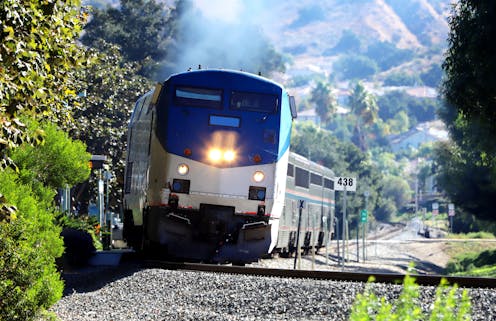Students ride the rails in this course to learn about sustainability and tourism
- Written by Mark Alan Rhodes II, Assistant Professor of Geography, Michigan Technological University
 Trains offer a unique glimpse at the American landscape. Laser1987/iStock via Getty Images Plus
Trains offer a unique glimpse at the American landscape. Laser1987/iStock via Getty Images PlusTitle of course
Amtrak Tourism: Trains, Cities and Sustainability
What prompted the idea for the course?
As a geographer, I wanted to offer a summer study abroad program on sustainability. However, it wouldn’t make sense to design a sustainability program that includes flying abroad due to planes’ excessive carbon footprint. Alternatively, Amtrak’s diesel-powered trains reduce per person carbon dioxide emissions by 40% compared with flying.
Aside from an environmental lens, I also wanted students to learn about sustainability from economic and social perspectives. During the program, students use only public transit, stay in locally owned lodgings and eat at locally sourced restaurants.
Combine my love of Amtrak with a desire to get students out of the classroom, and we found ourselves riding across the country to learn about sustainable tourism, landscapes and urban and regional planning.
What does the course explore?
Over the course of three weeks, students visit six locations, with overnight train rides between each ranging from 16-24 hours. The days are broken up into lessons on observing landscape and land use, sustainable tourism and urban deindustrialization, with at least an hour of class time on each train ride.
Destinations serve as living laboratories for our students. Classes in some cities, such as Galesburg, Illinois, or Sacramento, California, lean more heavily on exploring the cities’ industrial histories, also known as industrial heritage. In cities such as Portland, Oregon, or Glenwood Springs, Colorado, which experience large influxes of visitors every year, we focus more on tourism and planning.
Why is this course relevant now?
The federal government is investing billions of dollars to create a “new era of rail” in the United States.
The course appeals to millennial and Gen Z students who are increasingly concerned about the climate crisis and continued carbon emissions. The experience gives students real-world examples of how they can make a difference, such as through engaging with public officials and changing small habits in how they travel.
What’s a critical lesson from the course?
Tourism will not save a community.
While staying in Glenwood Springs in Colorado, students complete an assignment about “destination tourism” – when tourism becomes the primary driver or economic base of a region. Students ride the country’s only rapid rural bus transit systems “up valley” to Aspen. On the bus, they come to understand what they’ve read in the “The Slums of Aspen,” a book about how the elite ski town passed a resolution that pushed out their immigrant workers, who live farther and farther “down valley” due to gentrification but still work in Aspen.
Once students arrive in Aspen – during the offseason, in May – they find a polished ghost town full of Prada, Dior and other high-end fashion stores and highly manicured city parks. After returning to Glenwood Springs, they reflect on the differences between the cities in terms of housing costs, sustainability and tourism labor. They also walk away with a more critical eye toward water access, the seasonality of labor, public transportation availability and Indigenous rights in our college’s own area – the Keweenaw Peninsula.
What materials does the course feature?
Students read journalist James McCommons’ “Waiting on a Train: The Embattled Future of Passenger Rail Service,” which provides both historical and engaging context organized by route and destination.
With about 100 hours aboard Amtrak trains, I also assign students podcasts such as “99% Invisible” and “Working Class History.” I often see students on the train listening to podcasts with their headphones and writing journal entries that are due every time we arrive at a new hotel.
What will the course prepare students to do?
After finishing this course, the students – who are predominantly from rural areas in Michigan – have a better understanding of how and why they can use public transportation in their daily lives and travels. They also have a greater understanding of the positive and negative impacts of tourism on a place, particularly in postindustrial communities, and how they can be more intentional tourists themselves. Ultimately, they learn how they, as travelers and community members, can contribute to a more sustainable and equitable future.
Mark Alan Rhodes II does not work for, consult, own shares in or receive funding from any company or organization that would benefit from this article, and has disclosed no relevant affiliations beyond their academic appointment.
Authors: Mark Alan Rhodes II, Assistant Professor of Geography, Michigan Technological University
